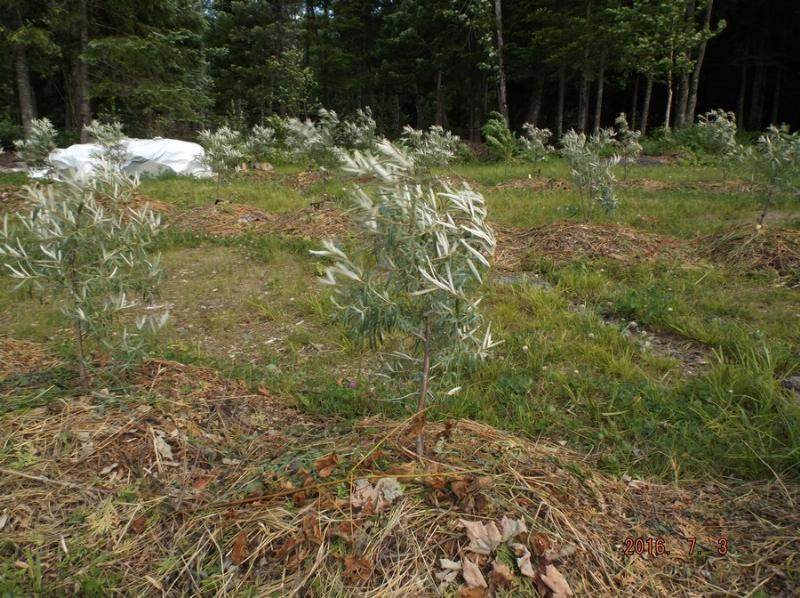




 2
2




"People may doubt what you say, but they will believe what you do."

 3
3




![Filename: Collecting-seabuckthorn-Ladakh.jpg
Description: [Thumbnail for Collecting-seabuckthorn-Ladakh.jpg]](/t/59010/a/43718/Collecting-seabuckthorn-Ladakh.jpg)
Works at a residential alternative high school in the Himalayas SECMOL.org . "Back home" is Cape Cod, E Coast USA.





http://www.popcliq.com (web development), GoPermaculture Food Forest http://www.permies.com/t/57687/forest-garden/Permaculture-Food-Forest-suburban-permaculture, Sea Buckthorn (Seaberry) grower (hobbiest) https://www.facebook.com/michelle.bisson.37, zone 3b/4b (borderline) Quebec Canada




Michelle Bisson wrote:
We are in the process of planting 120 or so sea buckthorn (seaberry) plants. 91 plants are already in the ground & the rest will go in once they go dormant in a month. I am trying to propagate them with various methods.
Some sea buckthorn varieties have less thorns than others. By cutting whole branches, every two years, the thorns are not as bad than if they are 5 years old. Of course care must be made when pruning and harvesting.
We'll see how that goes in the future since our plants are still young (3rd summer). I plan to propagate the young shoots into new plants, since this is an easy way to propagate them. One day we'll have extra to sell and trade. Because we planted our's as a hedgegrow layout, we will have plenty of pruning to do since our plants are closely planted at 3 feet apart with 9 feet between rows.
See my posts Go Permaculture Food Forest - Our Suburban permaculture journey to follow our journey.






 2
2




List of Bryant RedHawk's Epic Soil Series Threads We love visitors, that's why we live in a secluded cabin deep in the woods. "Buzzard's Roost (Asnikiye Heca) Farm." Promoting permaculture to save our planet.




http://www.popcliq.com (web development), GoPermaculture Food Forest http://www.permies.com/t/57687/forest-garden/Permaculture-Food-Forest-suburban-permaculture, Sea Buckthorn (Seaberry) grower (hobbiest) https://www.facebook.com/michelle.bisson.37, zone 3b/4b (borderline) Quebec Canada




http://www.popcliq.com (web development), GoPermaculture Food Forest http://www.permies.com/t/57687/forest-garden/Permaculture-Food-Forest-suburban-permaculture, Sea Buckthorn (Seaberry) grower (hobbiest) https://www.facebook.com/michelle.bisson.37, zone 3b/4b (borderline) Quebec Canada




Todd Parr wrote:They are planted in my chicken coop, so I doubt I will harvest many berries, instead leaving them for the chickens.
http://www.popcliq.com (web development), GoPermaculture Food Forest http://www.permies.com/t/57687/forest-garden/Permaculture-Food-Forest-suburban-permaculture, Sea Buckthorn (Seaberry) grower (hobbiest) https://www.facebook.com/michelle.bisson.37, zone 3b/4b (borderline) Quebec Canada




















List of Bryant RedHawk's Epic Soil Series Threads We love visitors, that's why we live in a secluded cabin deep in the woods. "Buzzard's Roost (Asnikiye Heca) Farm." Promoting permaculture to save our planet.





Living in Anjou , France,
For the many not for the few
http://www.permies.com/t/80/31583/projects/Permie-Pennies-France#330873

|
The government thinks you are too stupid to make your own lightbulb choices. But this tiny ad thinks you are smart:
The new permaculture playing cards kickstarter is now live!
https://www.kickstarter.com/projects/paulwheaton/garden-cards
|





